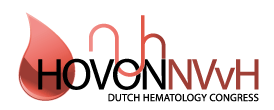First-line treatment for aplastic anemia in the Netherlands: allogeneic stem cell transplantation versus immunosuppressive treatment
Acquired Aplastic Anemia (AA) is a rare form of immune-mediated bone marrow failure, treated with either ATG-based immunosuppressive treatment (IST) or allogeneic hematopoietic stem cell transplantation (alloSCT). Based on adult AA guidelines, alloSCT is the preferred first-line therapy for younger patients with matched sibling donors. As older or frail patients will be preferentially treated with IST, a direct comparison between both treatments is not possible. Because in younger patients treatment strategy depends on the availability of a suitable donor, we compared the outcome of first-line alloSCT with the outcome of first-line IST in AA patients with comparable clinical parameters.
Dutch AA patients receiving first-line alloSCT between 2010 and 2020 were identified from the EBMT database and matched for age, gender, disease-severity and size of PNH clone with first-line IST treated patients from the Dutch AA registry. We compared outcomes between both treatment groups. Overall survival was evaluated using the Kaplan-Meier method.
Twenty-eight AA patients (median age 24 years, range 18-57, 54% with very severe AA) receiving first-line alloSCT (54% with sibling donor) were matched with 28 patients (median age 28 years, range 19-57, 54% with very severe AA) receiving IST. Median follow up after treatment was 37 (range 0-133) and 57 (range 6-122) months, respectively. Six months after start of IST, 10 patients did not respond and 9 proceeded to second-line treatment (7 received second-line alloSCT). One patient (4%) in the IST group died after alloSCT. A variety of conditioning regimens were used for alloSCT, among which ATG/cyclophosphamide (46%) and fludarabine/ATG with or without TBI (25%). Graft versus host disease (GvHD) prophylaxis consisted of ciclosporin with either methotrexate (46%) or mycophenolate mofetil (36%). Ten patients developed GvHD (5 acute, 5 chronic; 4 after sibling and 6 after unrelated donor transplantation) for which systemic therapy was needed. Five patients from the alloSCT cohort died: 2 due to GvHD, 1 due to infection, 2 due to transplantation related toxicity (cardiac failure and cerebral edema). Overall survival at 3 years was 82% after alloSCT versus 96% after IST.
We compared the two first-line treatment strategies for adult AA patients: alloSCT and IST. In this study, overall survival at 3 years after first-line alloSCT was not superior to overall survival after IST. Patient age and percentage of unrelated donors in the alloSCT group were higher than expected based on the guidelines and variable conditioning and GvHD prophylaxis regimens were used. In order to avoid the development of GvHD, which has no therapeutic benefit in a non-malignant disease like AA, uniform conditioning regimens and GVHD prophylaxis are proposed in the new Dutch AA Guidelines.

